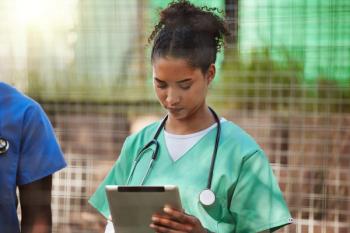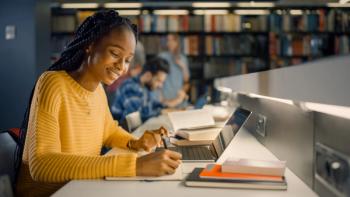
Designing the future
A look at veterinary-school architectural plans sheds light on how the profession is changing.
Yankee Stadium is set to be demolished soon, and its 85-year tenure as an American landmark is coming to a close. Built in 1923, it simply is no longer functional, given the changes that have taken place in the game of baseball and in the socio-economic way that current stadiums are used.
Fortunately, plans for a bigger and more modern stadium were developed even as the old stadium faded.
There are architectural firms that specialize in stadium design, creating designs based on where the sport and its fan base are anticipated to be in the next 15 to 25 years.
Likewise, there are architects who work solely on veterinary-school projects. Just as the design of modern stadiums gives good, direct evidence of socio-economic sports trends, the design of newer vet schools should provide a detailed look at what experts think veterinary education — and therefore veterinary practice — will look like in 25 years.
Peering into the future
"It's largely about planning for change ahead of time," says Roy Abernathy of FWAJDB, a division of the Atlanta architectural firm Jova/Daniels/Busby that concentrates on veterinary-school design. FWAJDB has been involved principally in design work for the College of Veterinary Medicine at the University of Georgia, the Veterinary College at North Carolina State University, the College of Veterinary Medicine at Auburn University, Ontario Veterinary College at the University of Guelph and other schools.
"We are very aware that veterinary equipment, and the physical areas needed for that equipment, are all going to change many times before we even open the school," says Abernathy. "Therefore modern design tries to incorporate flexibility in all aspects from heating and air (changing class size, clinic staffing and patient population all affect air, heat, water and sewer needs) to mill work (walls and partitions that are much less likely to be concrete block, long a staple for vet school and clinic/barn construction, and more likely to be detachable modular designs that provide durable infrastructure but less permanent construction)," adds Abernathy.
He has a rather unique perspective: Raised on a farm, he attended but did not complete veterinary school, instead receiving a degree in agricultural science and then in environmental design and architecture. This background allows him to understand the demands of veterinary education and practice in the context of limitations of space, economics and sometimes-conflicting interest groups, which are the challenges that architects must face.
An evolving process
The actual design process begins as a series of meetings. "We meet with all the departments and programs and try to find out the current strengths and deficiencies of the various areas," Abernathy explains.
Then the relationship between departments and clinical research/trials is evaluated. " Many of the veterinary schools are land-grant institutions," he says, "so they have a responsibility to give back to the public in the areas of research and education."
Additionally, much of the funding for improvement/renovation comes from research dollars, so this interrelationship must be addressed in future designs and ample space and facilities must be earmarked for continuation of strong programs.
"Funding determines, or at least greatly influences, design," Abernathy says. This sentiment is echoed internationally as well. The School of Veterinary Science at Bristol University opened in 1949 and has evolved over the years to meet the needs of increasing student numbers, expansion in program offerings and research themes. It is currently undergoing a multimillion-pound plan designed to enhance caseload for teaching, to provide cutting-edge technology and to improve customer focus leading to the development of a self-sustaining clinical business.
"In the 1980s and 1990s, most vet schools lost money," Abernathy explains. "But by 2000 most vet-school hospitals were break-even if not slightly profitable, with a concentration on new equipment, new and better service offerings and a commitment to working for and servicing referral business".
The initial design
Information obtained in all the initial meetings goes into the primary building design. Attention to flow and continuity determine which departments are next to which other departments— who gets more or less space and what types of support structures are needed for ophthalmology cases vs. dermatology cases, for instance.
"We take what we've heard," Abernathy explains, "design a building and then take that design back to the various departments." Mathematical models are run on the design, which can show changes in flow, time and space demands when parameters such as caseload, student population, clinical staff and equipment are altered. A second round of meetings further refines the design.
Much of the visionary input for design comes from steering committees, forward-thinking clinicians and vet-school deans, who often have a more broad-based idea of what veterinary medicine will look like in the future.
The current design project at the Ontario Veterinary College at the University of Guelph is focusing on where students fit into the clinical process. Many academicians recognize that current graduates often do not have the clinical "seasoning" to allow them to make a quick and easy transition into private practice. The large debt load that graduates have and likely will continue to have in the future makes their ability to more rapidly become contributing parts of a practice and to be better compensated for their contributions a crucial future consideration.
The planning that is going into the Ontario Veterinary College's new Hills Pet Nutrition Primary Healthcare Center is described by Elizabeth A. Stone, college dean.
"There was more than two years of collaboration with faculty, staff and students, combined with alumni and future employers of our graduates," Stone says.
"We asked them to reflect on current needs and where the gaps are in terms of new graduates. Once we had this information, we developed strategies, created goals for the initiative and met with various user groups to define the program. As a result, we decided that a free-standing, client-focused general practice was necessary for students to learn not only the medical aspects of veterinary medicine but also the client communication, business skills and team work necessary for career satisfaction and success. We did all this before we met with the architect. It's a time-consuming process.
"Flow of people in the new centre was critical. We are unique because the PHC will have students, staff, clients and pets in the centre at one time, and superb service delivery is a primary goal.
"There is no doubt that technology will continue to be more sophisticated and necessary in the next 25 years," Stone says. "The relationships between veterinarians and their clients will remain most important. ... I am concerned that there could be increasing numbers of animal owners who don't have access to veterinary care — such as food-animal owners, less wealthy pet owners. Hopefully we can find ways to use technology and practice teams to keep the cost of veterinary care within the reach of most animal owners."
Pulling in the students
Like the Ontario school, current designs for other schools of the future feature earlier integration of students into clinical situations. The most novel extension of this idea is the development of "round rooms" within a clinical setting. These glass-walled classrooms are designed into the clinical hospital so that first- and second-year students can receive more traditional classroom instruction but can also be kept a part of the flow of cases through the clinic with easier access to clinical teaching and correlation to basic science learning.
"This open ICU-like feel allows students to see procedures and observe diagnostics and treatments, and increases the caseload exposure," Abernathy says. "Traditional "block rotation" teaching restricts each student's experiences to the luck of the draw as to what types of cases and the number of cases seen during individual rotations."
This open, integrated teaching/clinic design also brings up the question as to what is the center of the hospital.
Admission and medical records traditionally served as the starting point for a clinical case, and this department required a lot of space. Digital records and information transfer has all but eliminated the need for large medical-records departments, and new vision sees radiology, pharmacology and clinical pathology (labs) as future hospital centers because patients still must physically move to these locations.
Additionally, new areas for holistic and acupuncture teaching and care, geriatrics, rehabilitation (with an emphasis on prosthetics) and oncology are seen as future areas of importance in veterinary teaching and practice and are being planned into designs.
The importance of specialty training is being applied to large-animal medicine teaching as well, and small herds of cows, sheep, goats and other animals are being raised organically or grown to produce target-group ice cream or cheese or other such items.
Other influences on design
These clients will demand specialty-skill veterinarians for their animals, and future teaching models will have to address this need while barn and clinic designs will have to include appropriate patient load for teaching.
Overall, it is not just the infrastructure of veterinary schools that is changing, but the methods of teaching and the goals and missions of the schools as well.
By looking at the design changes, however — the increased integration of students into clinical work, the overall stability of class sizes, the rapidly expanding incorporation of digital radiology, digital ultrasound, MRI and other new equipment, the development and emphasis on more recent specialty areas like oncology, geriatrics, epidemiology, obesity, and holistic medicine and the continued commitment to large animal teaching — we are provided with a look at where many see veterinary medicine moving in the near future.
Marcella is an equine practitioner in Canton, Ga.
Newsletter
From exam room tips to practice management insights, get trusted veterinary news delivered straight to your inbox—subscribe to dvm360.




